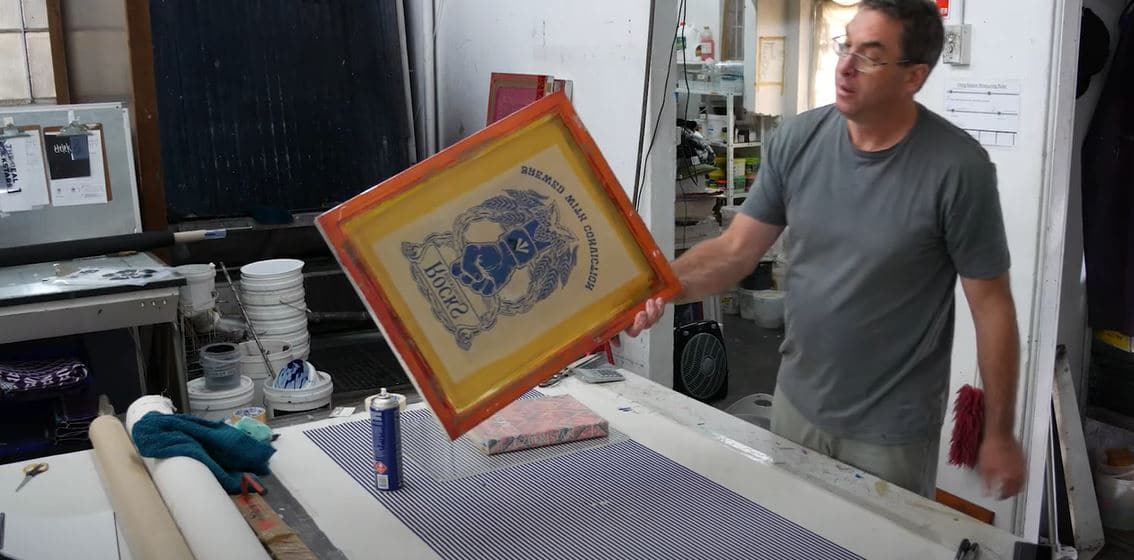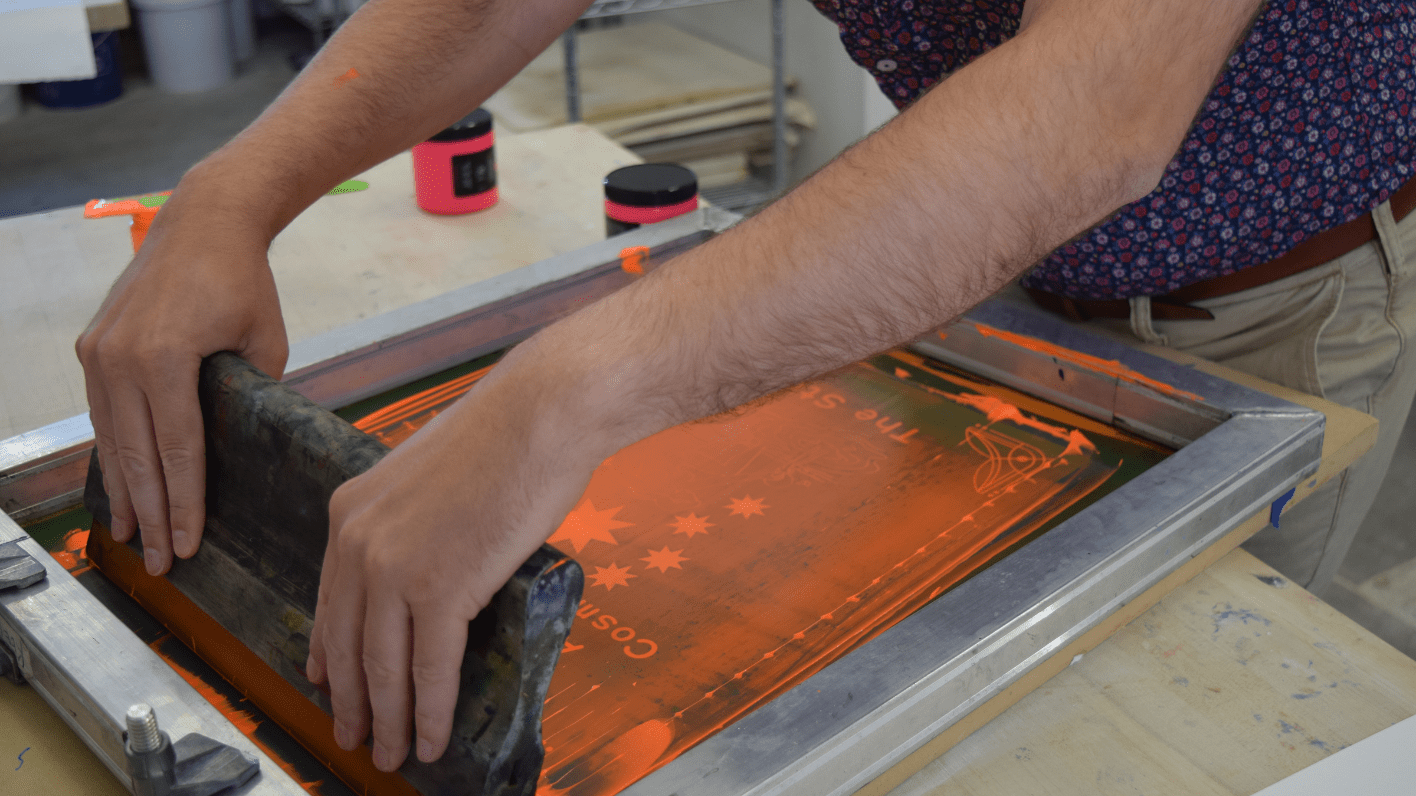Business Branding Services FAQs: everything entrepreneurs ask
Wiki Article
From Style to Distribution: Grasping the Art of T-Shirt Screen Printing
The trip from layout to distribution in t-shirt screen printing includes a series of critical points that demand attention to detail and critical planning. It begins with comprehending the subtleties of your target market, followed by the selection of appropriate products and the preparation of artwork that satisfies high criteria. Yet, as the procedure unravels, difficulties in quality assurance and logistics can occur, potentially impacting the final result. Discovering these intricacies discloses not only the complexities of screen printing but also the important techniques that can elevate a brand name's standing in an open market.Recognizing T-Shirt Screen Printing
Understanding T-Shirt screen printing includes identifying a versatile and commonly utilized method for moving styles onto textile. This method uses a pattern and a mesh screen to use ink onto different fabric materials, primarily cotton and polyester blends. The procedure begins with the creation of a screen that includes the desired design, which is then very carefully straightened on the fabric.Ink is pushed with the screen's open locations making use of a squeegee, enabling specific application of color. This approach is preferred for its capacity to produce lively, lasting prints that stand up well to washing and put on. Additionally, screen printing is qualified of fitting both simple and complex designs, making it a recommended option for custom garments, advertising products, and even artistic jobs.
Additionally, screen printing supplies scalability, making it ideal for both small set orders and large productions. While initial setup expenses might be greater contrasted to various other printing methods, the effectiveness and longevity of screen printing frequently justify the financial investment. In general, recognizing the fundamentals of Tees screen printing is vital for any individual aiming to take part in this prominent type of fabric decoration, whether for industrial ventures or individual jobs.
Conceiving Your Design
Conceptualizing your style is an essential action in the T-shirt screen printing process, as it sets the foundation for the whole job (Business Branding Services). This phase entails creating ideas that reverberate with your target market while guaranteeing that the design aligns with the brand name's identification and message. It is essential to start by checking out themes, color pattern, and graphics that reflect the intended aestheticSketching initial concepts can be beneficial, allowing for a graph of concepts prior to wrapping up the layout. Think about using typography, imagery, and layout in a manner that records attention and connects properly. Furthermore, it is important to expect the printing method that will be utilized, as this can influence design complexity and color choices.
Participating in brainstorming sessions with group members or looking for comments from prospective clients can likewise enhance the conceptualization procedure, supplying varied perspectives that improve the layout. Inevitably, a well-balanced layout not only improves the visual charm of the Tee shirts yet likewise promotes a link with the target market, driving interest and potential sales. Dedicating time to conceive your layout can lead to an effective screen printing result.
Selecting the Right Products

The weight of the textile, usually determined in grams per square meter (GSM), affects the drape and total feeling of the Tees. Heavier textiles might provide a much more superior appearance, while lighter alternatives fit for informal wear. Appearance likewise contributes; smoother materials tend to produce sharper prints, while distinctive surfaces can develop unique aesthetic effects.
In addition, think about the ecological effect of materials. Organic cotton and recycled polyester are acquiring appeal amongst eco-conscious consumers. Inevitably, choosing the appropriate materials involves balancing aesthetic allure, functionality, and sustainability, guaranteeing that the T-shirt not just looks wonderful yet also satisfies the expectations of your target market.
Preparing Art Work for Printing
Preparing art work for T-shirt screen printing needs mindful attention to detail to ensure that the final print precisely shows the intended layout. The initial step is to produce a high-resolution digital documents, ideally in vector layout, as this permits scalability without loss of high quality. Usual software used for this purpose consists of Adobe Illustrator and CorelDRAW.Next off, confirm that all text is transformed to outlines or rasterized to avoid font issues throughout printing (Texas Screen Printing Experts). Additionally, it is essential to validate that the color setting is set to CMYK, as this straightens with the printing process. Pay attention to shade matching; using Pantone shades can help accomplish uniformity across different prints
Think about the dimensions of the print location and maintain correct margins to avoid style cutoff. It's also a good idea to consist of registration marks for positioning throughout the printing procedure. T-Shirt Printing. Request an evidence from the printer to envision the final product before mass production. This step is vital for recognizing any kind of potential concerns, ensuring that the published T-shirt satisfies the wanted top quality and design specifications. Appropriate preparation of art work significantly affects the general success of the screen printing task
Understanding the Printing Process
Mastering the printing procedure is vital for attaining high-grade results in T-shirt screen printing. This phase includes a number of significant actions that straight affect the final product. The first step is establishing the printing press properly. Proper enrollment of displays assurances that shades align correctly, protecting against misprints and guaranteeing a professional appearance.
Next off, selecting the best ink is vital. Various ink kinds, such as plastisol or water-based, deal various coatings and durability. Comprehending the fabric make-up of the Tee shirts also assists in selecting compatible inks.
Managing the squeegee stress and angle is vital when it comes to the actual printing. Constant pressure will certainly produce also ink distribution, while the angle impacts the flow and protection. Additionally, readjusting the rate of the printing press can influence the ink's healing procedure, which is basic for guaranteeing resilience.
High Quality Control and Finishing
After the printing process is complete, carrying out effective quality assurance measures comes to be crucial to verify that each T-shirt meets the desired standards. Quality assurance includes a methodical strategy to inspecting each garment for defects, validating that the print high quality, color accuracy, and material stability align with the requirements established during the style stage.
The very first step in high quality control is a detailed visual examination. This entails monitoring for common concerns such as imbalance, ink smudges, or fading. Any T-shirt that does not meet the quality standards must be resolved quickly, either through reprinting or fixing.
In enhancement to aesthetic checks, it is very important to conduct laundry examinations on an example of published tee shirts to evaluate the toughness of the inks and the total long life of the layout. These tests assist verify that the print will certainly keep its vibrancy and integrity after several cleans, a vital variable for consumer satisfaction.
Ending up touches, such as string trimming and the application of treatment labels, also play a considerable role in quality assurance - T-Shirt Printing. By concentrating on these facets, organizations can improve the general discussion of their items, inevitably causing an extra satisfying consumer experience
Product Packaging and Shipment Solutions

To achieve ideal product packaging, think about utilizing eco-friendly materials that align with sustainability trends, such as recyclable poly bags or eco-friendly boxes. Each T-shirt ought to be nicely folded and put in protective covering to avoid creasing and prospective damage throughout transportation. Consisting of a top quality insert or treatment directions can better customize the experience, fostering consumer commitment.
Choosing a trustworthy delivery companion is vital when it comes to delivery. Review options based upon price, speed, and monitoring capabilities. Supplying several shipping methods can accommodate different consumer requirements, from typical to expedited delivery.
Frequently Asked Inquiries
What Are the Common Mistakes Newbies Make in Screen Printing?
Common errors newbies make in screen printing consist of improper screen preparation, inadequate ink mixing, inaccurate direct exposure times, insufficient treating, and neglecting to examine prints. These errors can bring about inadequate top quality and unsuitable outcomes in last items.Exactly How Can I Stop Ink From Bleeding Throughout Printing?
To prevent ink bleeding during printing, assurance correct screen tension, usage ideal emulsion thickness, choose the ideal ink uniformity, maintain excellent curing temperature levels, and prevent overwhelming the screen with too much ink throughout application.What Sorts of Inks Are Finest for Different Fabrics?
Choosing inks based on fabric kind is crucial. Water-based inks are optimal for cotton, providing gentleness. Plastisol inks match synthetic materials, using longevity. Discharge inks properly blend with natural fibers, making sure dynamic colors without jeopardizing textile stability.Just how Do I Pick the Right Screen Mesh Matter?
Selecting the appropriate screen mesh matter depends on the preferred print detail and ink kind. Abilene T-Shirt Screen Printing Company 10:9 Design Business Branding Solutions. Higher mesh counts generate better information, while lower counts help with thicker inks. Assess material type and style intricacy for suitable resultsCan I Make Use Of Screen Printing for Tiny Batch Orders?
Yes, screen printing can be successfully utilized for tiny batch orders. This approach permits thorough styles and high-quality results, making it a viable choice for customized clothing, marketing items, or restricted edition runs.Recognizing T-Shirt screen printing includes recognizing a flexible and commonly made use of technique for moving layouts onto fabric. While preliminary arrangement costs might be higher compared to various other printing approaches, the performance and toughness of screen printing often validate the financial investment. Preparing art work for T-shirt screen printing needs careful attention to detail to assure that the final print accurately mirrors the intended style. Understanding the printing procedure is essential for accomplishing high-grade outcomes in T-shirt screen printing. Usual mistakes novices make in screen printing consist of improper screen preparation, poor ink blending, incorrect direct exposure times, inadequate healing, and overlooking to evaluate prints.
Report this wiki page